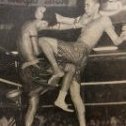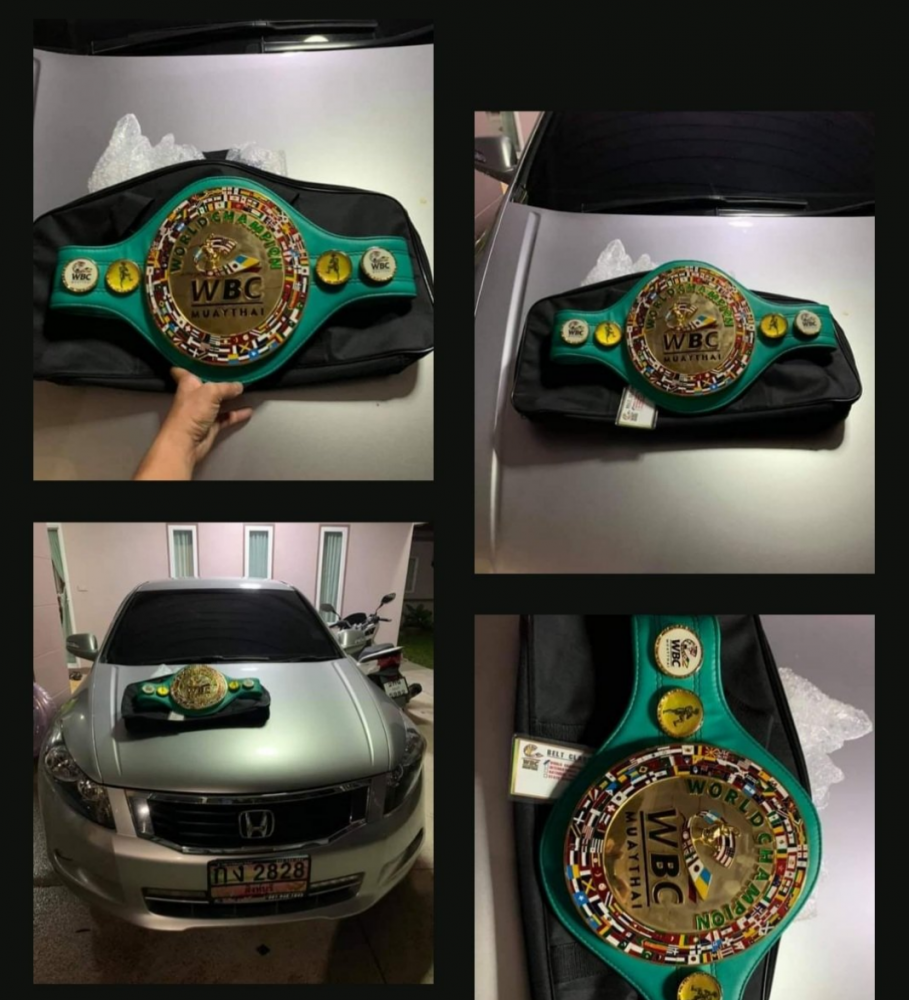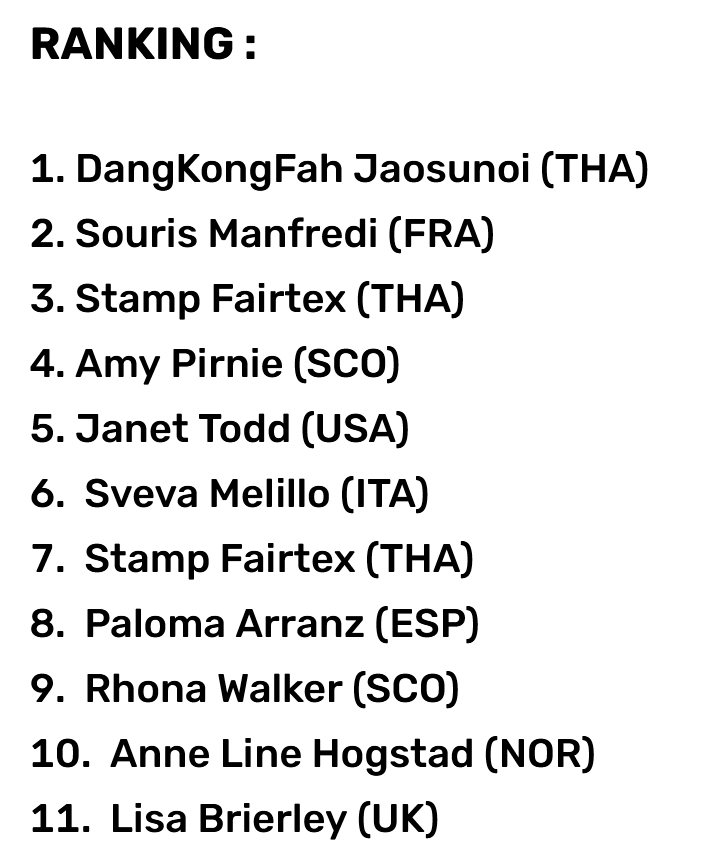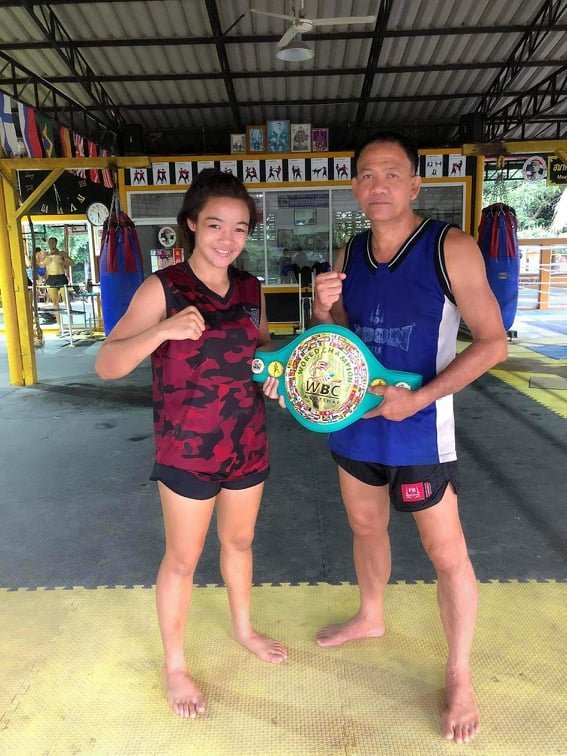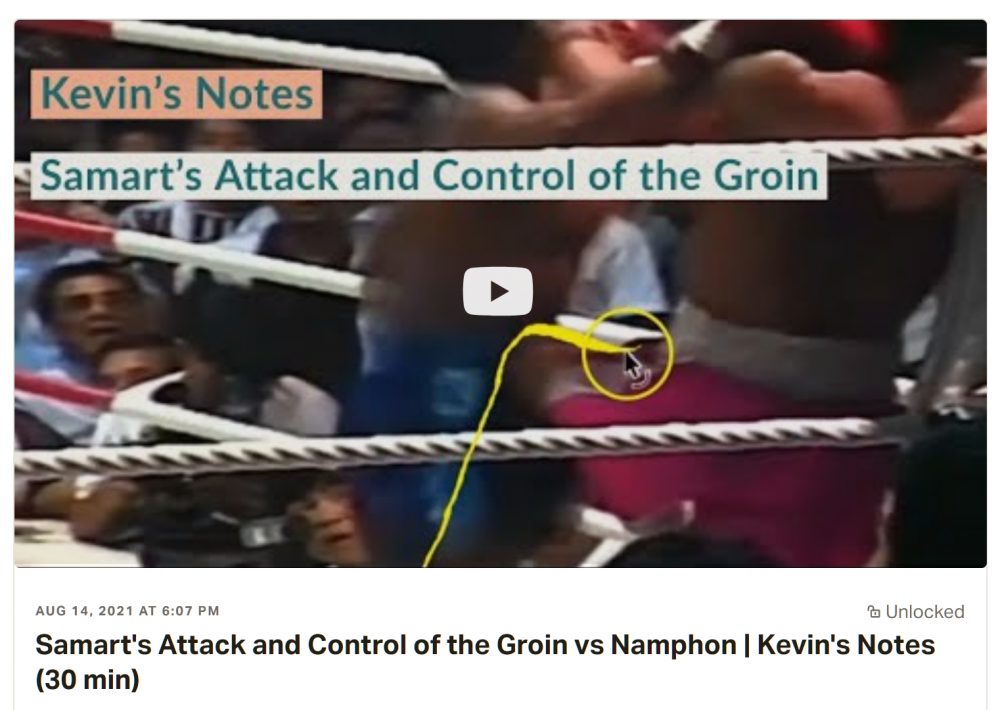Leaderboard
Popular Content
Showing content with the highest reputation on 11/09/2021 in all areas
-
Perhaps shorts and t shirts with profits to the good man's family? He was well known and loved in Europe1 point
-
One of the more compelling female Muay Thai fights happened this week, a WBC Super Flyweight, Muay Thai World Title fight between Souris Manfredi (France) and Dangkongfah Soujainoi (Thai). The fight itself was action-packed, and also pitted quite different fighting styles and skill sets against each other, enough to make it interesting on its own, but perhaps even more so, the stories behind the fight and what it meant brings interest and thought to the match-up. I'm writing here to call in a few more of those details to bring more attention to the fight, and its place in the development of female Muay Thai. Sadly, at this point in female Muay Thai fight history even big fights like this just get an Instagram post with a belt, a few shares and vanish. Instead, there are deep stories and lives that come together in these fights worth writing about. The importance of the fight may start here, with the WBC world rankings of female fighters (below, the top 10 listed in the weight class of this title - unfortunately due to an update typo Stamp is listed twice). The WBC over the last 6 months or so has been working hard to develop a world ranking for female Muay Thai fighters with an international scope in mind. It's extremely hard to grasp Thai and western, and Asian female fighter fight scenes in a single list. They are so diverse, and the Thai landscape changes so quickly, it has felt like a Herculean task to even come close to something fair, timely and accurate. The WBC has thrown all its effort into this, so much so it seems that the competing WMO has followed suit and attempted their own rankings recently. The WBC's is here, the WMO's is here. It's actually good to have competing orgs attempting to build pictures of female fighting excellence because it's so hard to do. As someone close to the pulse of female Muay Thai in Thailand I can see where these rankings can fall short, simply because logistically you have to rely on a select few as advisers, people who are in the game, and each will have their own political alliances, fighters they necessarily are connected to. It's just the reality of rankings as they are very difficult to create, and organizations that work hard to make and maintain them deserve great credit. With two organizations creating rankings though it helps fill in the gaps any one might have. In any case, this was a huge fight in the context of the WBC's effort. They had already had their first WBC belt fight between two Thai female fighters, Sanaejan and Buakaw, with Sanaejan winning the belt at Mini-Flyweight, a fight fought in the Lumpinee parking lot improvised studio due to COVID restrictions - otherwise it would have been the first female fight in Lumpinee Stadium itself, an epic moment in Thai history - the first fight IN Lumpinee Stadium has been scheduled, read about that here. This fight between Souris and Dangkongfah represented the very first to reflect the wide-scope goals of the WBC, the international aims, as it pitted a very solid, experienced fighter from the west vs a very solid, experienced fighter from Thailand, top ranked, bringing the two worlds together. One can get the feeling that these preliminary rankings are in part assembled in order to put on these kinds of fights, for instance opponents can suddenly be added to the Top 10 rankings at the last minute before proposed matchups, but the reality is that we have to start somewhere. We have to start with a picture of the best, and then the best can start fighting each other and determining a truer sense of what an accurate ranking might be. This is exactly that kind of fight. It's the first time under the new WBC ranking system that western and Thai well-known, acknowledged fighters faced off, to create a real hierarchy, and this is exciting stuff. You can see the fight here below, an edit from Dangkongfah's corner Facebook stream: There's more to this match up than meets the eye too. There is a history between these two fighters, and for Dangkongfah a really compelling story that has covered maybe the last 5 years. If I'm not mistaken, Souris had beaten Dangkongfah several years ago in Khorat, in a fight that Dangkongfah protested as a dubious decision. This was earlier in Souris's development as a fighter, when she was with her coach Charleton in his gym in Khorat (both fighters were local to Khorat at that time). They were way off the beaten path, training and fighting away from the bigger shows that people in the west hear about. It's very hard to go your own way in Thailand, so serious props to both of them, (forgive me, as close as I follow female Muay Thai, the details on this are a bit muddy, I'm just trying to draw a broad brush). Surely this victory was a meaningful one. Dangkongfah was, I also believe, simply a young circuit festival fighter at the time, and I'm guessing was up in weight, so likely had that advantage. In fact Sylvie had a remarkable experience with Dangkongfah several years ago when fighting up in Khorat. A (then) pudgy young fighter who was drawn to Sylvie for some reason inserted herself into Sylvie's corner (Sylvie had no corner for this fight and just collected one from the local krus on the mats), and helped urge Sylvie onto victory. You can see clips of this here. We've had some pretty amazing experiences in Isaan, but finding this assertive, confident girl in support may have topped them all. She was full of vitality, confidence, a kind of magnetic enthusiasm. In fact, after the fight she told Sylvie that she wanted to fight her, "just for fun." Sylvie just laughed. Dangkongfah was 16 years old (looked 14 to us) and we guessed close to 60 kg (Sylvie is consistently around 46 kg). You can see that fight and her in Sylvie's corner here. Dangkongfah had won her own fight fairly spectacularly, earlier on the same card. In any case, it introduced us to this incredible energy of a girl. Maybe a year or two later we heard that Fairtex had taken in Dangkongfah, a bit after they had taken on Stamp, starting their commitment to develop a female Muay Thai and MMA fight team. This was in the very beginning of it all. I don't want to be hard about it, but just to generalize from talking to others close to the situation, at the time the feeling seemed to be that Stamp was the real, serious prospect. Stamp was maybe a top 5 female fighter in her weight class in Thailand at the time, coming off a difficult, somewhat blowout loss to Phetjee Jaa, but beating Sylvie at 48 kg. Dangkongfah was instead an overweight, Isaan festival circuit fighter, a funny girl, who was taken on in a different way. There were stories of her being without means of support, I believe, though I'm not sure how much that was so. Her father is the famous fighter Kongfah, for whom she is named. It's enough to say that it may have been a bit of a feeling of charity and generosity in how she was taken in at this early stage of their female fight team, an out-reach from the Fairtex side, not expecting a star prospect. She and Stamp were the first two female fighters of Fairtex. Stamp then was molded into a ONE Championship superstar, and at some point Dangkongfah, having worked very hard to get into significantly better shape while there, left Fairtex. It's difficult to describe this position she was in with enough force. Thai female fighters until a few years ago, had very few career opportunities by the time they turn 18. The best female Thai Muay Thai fighters were all 14 or 15 when they were fighting as prize-fighters very frequently, in the circuits, developing great skill and game-finesse, but once they hit about 16 everything pretty much starts to shut off. You could join the Thai National team and be awarded big money from the government if you get Gold at IFMA World Championships. You could maybe occasionally fight a high-profile fight for a big dermpan, but your training inevitably tails off, your fight opportunities tail off. When Dangkongfah left Fairtex (and I don't know the circumstances of that), she was literally looking at the end of opportunity. She was not that developed in terms of skill, but certainly rich in experience. She was not the best circuit fighter in Isaan, like someone like Loma was. She had just left a huge name in Fairtex that was at the cusp of investing lots of money, and lots of will into building and promoting Thai female fighters. Fighters like Wondergirl and now Dokmaibaa have since joined the team. And Stamp took off like a rocketship, not only as a fighter, but a promoted fighter with a prominent fight program invested in building her name and career. Dangkongfah stepped out of that wake, into what really might be expected to be Muay Thai oblivion, for a Thai female fighter. But...fueled by the example of ONE promotional success, when Channel 8 broke from its MAX Muay Thai contract they started their own version of MAX, with two weekend shows in Superchamp and Muay Hardcore. Whereas MAX had barred women from the ring (Sylvie is one of only 4 female fighters who ever fought in MAX Stadium), the Channel 8 fights did the opposite. They took the lead from ONE and made female fighters, in fact it was Thai female fighters, their headline stars. First, it was Sawsing, a natural star given that she had long been one of the best female fighters in Thailand, but then, interestingly enough, they took on Dangkongfah as a headline fighter as well. From the outside, it would seem like they plucked her out of nowhere. She was not riding a long wave of success, at least not outside a very local scene. She was just an Isaan fighter who hadn't fought very much recently (because she'd been at Fairtex) but with a big heart and energy. But, she matched the Entertainment Muay Thai promotional model perfectly. I've written a lot about how worrisome the Entertainment Muay Thai rulesets can be as a threat to traditional Muay Thai, but...they are also an opportunity. And Dangkongfah thrived under the format. She ascended. What I really love about her as a fighter is how much she defies the passionate westerner perceptions of Muay Thai excellence. We have fantasies of incredible crispness and balance, the effortless gliding across the ring, the impression that you are above the fight through skill and acumen. There are so many examples. You look at Dangkongfah and you see none of that at first blush. But I'll tell you, she is a fighter who has earned with experienced qualities that are intimately Thai, those of the Thai fighter. It's just not the things that appear easily to the eye. It isn't demo-perfect Muay Thai. It's the Muay of experience, it's "bones", as Thais call it. It's the Muay of prize fighting. Yes, what makes Thailand's Muay Thai so special IS the beauty of techniques...but beneath those techniques is another beauty. It's the beauty of the experiences of fighting itself, since a young age. What is so cool about Dangkongfah as a fighter is that because - unlike many Thai female fighters who do express quite beautiful Muay Thai - she does not have those keynotes that people look at for symbols of excellence that in some Thai female fighters can be a kind of "point fighting", she has the other excellence, the excellence of feeling a fight, directing a fight, knowing how to win a fight, and it shows through. This is not a knock on other fighters, many technically crisp fighters also possess this fight knowledge, but her particular mix of fighting skills allows this very special quality of hers, to shine. The "bones" show. It's not easy to see if you aren't looking for it. So, a bit of digression to bring it out. Many not familiar with Thailand's traditional Muay Thai scoring don't really grasp the importance of a narrative scoring model. You can read more about this here: The Essence of Muay Thai – 6 Core Aspects That Make it What It Is. The narrative model means that you have to tell a story in a fight. Progress in what you reveal, in the tempos and momentums that you choose, and they mean something in terms of what has already happened in the fight. Round 3 means something in relation to rounds 1 and 2. Round 4, in relation to round 3. Dangkongfah has been a prize fighter under narrative scoring since a kid. It's not "damage" or calculated "points", it's how much you control the narrative of the fight. It's how much you dominate, and WHEN. Everything builds to a story of your dominance. This is what she is really good at. And you'll see it in this fight. She has a feeling for when and how. It doesn't matter if punches flail out and are ineffective at some point, or if she momentarily loses balance, it's about when they land, and when she's rock solid. When the car gets rolling, she knows how to push. A lot of Thai female fighters will not risk the loss of control (beauty) to get to where she wants to get. She's very unlike many Thai female fighters that ascend to a wide-spread awareness, and it is easy to underestimate her. She is all the guts and IQ that come from fighting as a prize fighter since a kid. If you want to know what she's about, watch her in rematches. She is ridiculously good at rematching an opponent. I've watched her fight many times. Sylvie has fought her, I've seen her fight twice in person. She has a focus and will in rematches that just controls the game. She escaped with a lucky (probably biased in her favor) draw decision vs Dani on Channel 8, and just ripped her in the rematch despite giving up what seemed like visible size. She beat one of the best fighters in Muay Thai on Channel 8, the brand new ONE Championship Champion Allycia Rodriguez (who had just defeated Stamp for the title), rematching her for the biggest side bet of any female fight in Thai history (1 million Baht) and the Thailand title belt, and totally controlled the fight against someone most would say was technically superior. (At the time Dangkongfah had been using social media to argue that she deserved to fight for ONE, the promotion which made Stamp a star, and then out-right beat their brand new champion, who had defeated Stamp for the title... it was a solid argument.) She firmly beat Souris on Channel 8, in a 3 round rematch from their disputed Khorat fight, and so this WBC fight was again a rematch. Anytime I've seen her rematch she's dominated, almost magically. It's not an accident. And, this fight was coming off her first true loss in years, having lost to Barbara Aguiar on Channel 8. She had something to prove. It was a pretty extraordinary performance, this WBC title fight. Souris Manfredi, though she does not have wins versus other WBC ranked fighters (that I'm aware of) has nonetheless taken on HUGE challenges as a fighter, with tough-fought losses to Phetjee Jaa in Thai Fight (maybe the best female MT fighter in the world), a big weight discrepancy vs top fighter Sawsing on Channel 8 and against Dangkongfah herself. She went to Myanmar to fight and win a Lethwei title, and has fought and won in in a Bare Knuckle promotion in Thailand (a promotion her coach just announced she's now pursuing full time, leaving Muay Thai permanently). Stylistically this is a great fight, because just watching Souris you can see how hard she's trained in specific techniques and positions. She's crisp, sound and exudes discipline and commitment. For instance she has lots of early success with nice straight punches that seem to pop through a seemingly porous guard. She looks superior. She presents Muay Thai in a highly trained, well-defined way that is clearly visible to the eye. You can feel that she's worked extremely hard at developing herself. Because we in the West kind of exoticize the precision of Thailand's Muay Thai, we work very hard at tracing those perfect lines, and capturing them in combination. What is so interesting and cool about this fight is that Dangkongfah, somewhat unusually, doesn't have that supposedly "Thai" precision. A legend we know privately wrinkled his nose at Dangkongfah's victory over Alycia, preferring the latter's technique even though the win was clear. A coach might look at her on tape and think: she's full of holes, she's easy to pick off. You can make game plans, and be right about it all...but just try. She has something deeper than technique. She has a feel for the game, she's been a prize fighter since she was young. She made this in the festival fight circuit of Isaan, where "pretty" isn't really what it's about. It's about taking that sidebet when its up for grabs, controlling the narrative and it's about heart. It's a deeper lesson of what fighting is. It isn't picture-book. The Muay Sok legend Yodkhunpon once told us of growing up in the fighting rings of his boyhood Isaan "points are for Bangkok". Drawing from another sport, in baseball you talk about pitchers who have amazing "stuff", and then you talk about pitchers who know how to win even if they don't have great stuff. Dangkongfah is that kind of pitcher, she knows how to win. The final context of this fight is even more remarkable. The fight took place in an improvised ring at the Fairtex Training Facility in Pattaya, the very same place she was the Cinderella step-sister of now world famous Stamp. In fact everyone in attendance to this title fight watched Stamp go through training a few hours BEFORE this fight. One cannot help but feel Dangkongfah herself took into the ring with her that contrast between Stamp and herself, the one who Fairtex embraced and built and she herself who went her own road. Here she was fighting for the WBC World Title in the very same space she was in when she was a pudgy funny-girl from Isaan. Finding herself there in that ring in Fairtex was an unexpected twist of fates. This World Title fight was actually supposed to be the showcase fight under the Lumpinee banner under GoSport's new push to create a different kind of promotion for Lumpinee Stadium. A New Lumpinee. When first proposed I imagine there may have even have been a chance that this fight was going to be the first ever INSIDE the ring of Lumpinee (which has at the time of this writing not happened yet but is scheduled), and maybe even for a WBC belt and a Lumpinee belt (early promotional material from GoSport had both belts advertised on female fights). But, as it happened, GoSport and the WBC had a disagreement, the contract for the belt experienced complications, and the fight found itself on this promotion, Full Metal Muay Thai, put on in the Fairtex facilities due to COVID restrictions. It's enough to say, this fight took a swerve from a possible pinnacle place in Muay Thai history, to a place of personal importance for Dangkongfah. Not Lumpinee, but at Fairtex where she once may have been underestimated. This is the underdog girl. Sawsing, who had come with her family and team of Thai female fighters to support Dangkongfah, posted this photo of the WBC belt on the hood of the car they drove down in from Singburi, that's how special it was for them. Interestingly enough Yannick, a Frenchman who owned Warriors gym in Pattaya, is the generous man who held the contract for the belt. He had purchased the belt (a significant expense) because he felt felt that it was ridiculous that a fighter who becomes World Champion does not get to keep the physical belt in Thailand. Many do not know this, but this is true of Lumpinee belts, Rajadamnern belts, pretty much all belts. So he in real generosity also purchased the belt itself to go to the winner. One imagines he hoped that this belt would go to Souris Manfredi, who also from France. Instead it was wrested away by the festival fighting girl from Isaan, the remarkable, incredible Dangkongfah. If you want the latest in Muay Thai happenings and things to inspire: sign up for our Muay Thai Bones Newsletter1 point
-
Thanks for the suggestion. We can't do that merchandise right now, but if anyone wants to donate to his family we can send the money to them. This is our crowdfunding site. We cover all transfer fees. Just send me a message saying how the donation is for: https://www.indiegogo.com/projects/support-muay-thai-legends-in-the-covid-19-shutdown#/1 point
-
Here is Dangkongfah posing with her belt the next day with Kru Diesel who helped her train a bit before for this fight out of Fight House in Singburi. Dangkongfah a week before her WBC fight also fought in the National Amateur Muay Thai tournament, a yearly event only among Thais, and took Silver in her weight class.1 point
-
This as a lengthy answer I posed on Reddit in answer to someone who was attempting to get ahold of the greatness of Samart. He had read some articles and seemed to keep coming up against repeated appeals to his "IQ" and lots on his side teep. As easy as it is to admit or even claim that Samart is the greatest, because so much of his career is unrecorded on video, his celebration does sometimes feel a bit vague. This was my take: The greatness of Samart has a kind of mythological quality to it, as there is almost no footage of his fights in his prime. This means that we kind of fill in the hole in the historical record with his projected greatness. In boxing history this happens as well, you can hear very knowledgeable people talk about Harry Greb (1920s) with reverence, taking him to be as great as anyone who ever fought, with no fight footage. The story of Samart's greatness kind of flows from a few directions. First of all, its about when he fought. He changed the game as it transitioned from the Silver Age of Muay Thai to the Golden Age. I write a bit about this here, he MOVED like nobody else, maybe before or since, but was kind of the first to do it: This gives his a special aura that fighters in history have. They change the sport. The other part of this is, in Thailand itself, and by the fighters themselves, he is regarded as the greatest, maybe the way that Jordan is in basketball. Jordan rode the wave of a sudden popularization and huge economic growth of the sport, and also came to define it. It wasn't just that Jordan was incredible, its the Time he played in, and the aura he developed as his brand in the NBA in terms of marketing awareness exploded. After Samart retired he made movies, he became a handsome singing star, he became a SUPERSTAR, culturally. This is important, because Muay Thai fighters in Thailand have had a stigma of being low class. He was kind of a James Bond of Muay Thai, just as Muay Thai was peaking in popularity. This charm and popularity, beyond the world of Muay Thai, is no small thing to Thais, and to Thai fighters who were his contemporaries. He was a cross-over star. To us, maybe not a big deal, but to Thais huge. Your aura is what you are as a fighter, and his aura grew well beyond the ring. Thais call it sanae, meaning something like charm, but carrying with it the feeling of invulnerability. A "you can't touch this" aura. Legends of the past complain that fighters of today do not have this. Then you add in his WBC World Title. He wasn't a World Champion for very long, other fighters like Weerapol have been WBC champion more prolifically, but for Thais boxing brings much more International honor than being a Lumpinee Champion. The country celebrates and idolizes its boxing champions, especially from that era. Some of Thailand's wide reverence for western boxing excellence came from the strong patronage of boxing from H.M. Rama IX, who not only modernized Thailand's Muay Thai, but also held boxing in extremely high esteem and helped promote it. That Samart and the King had the same birthday date (December 5th) probably only added to the magical connection, in a country where days and dates really matter. So, when you talk with Thais it's all Samart. The other layer of this is that western, English language coverage of Samart becomes exaggerated and embellished (probably), because of his immense reputation in Thailand. A super gifted fighter with great eyes, a fighter who moved like no other, a WBC Boxing World Title, and almost none of his prime captured on tape, its a recipe for idolization. Just as with Jordan, there are arguments to be technically had against his GOATness, if you want to dig into everything. He almost never fought up, and sometimes fought down, so, powerful enough connections gave him matchups that were favorable, albeit against a very strong field. This is unlike many great fighters who were forced into weight classes that were not their own, once they cleaned out their own natural weight division. Gym and matchup power is a very important aspect of career greatness, ask Somrak about that. You can say he wasn't a great clinch fighter, more of an anti-clinch fighter, and that he lost badly two of the more high-profile fights he fought vs Dieselnoi (for FOTY) and Wangchannoi (his final stadium fight). It even could be said that if Samart hadn't come back from boxing to win his 3rd FOTY, his older brother Kongtoranee, who is largely forgotten by English language history, could have had an even better career with more stadium belts, 2 FOTYs, and coming within a hair's breath of winning a World Title in boxing (if I recall?) But these are just jostling greatness next to greatness. To the Thais, pretty uniformly, he is the greatest. You can see the votes we tallied among ex-fighters as to who is the GOAT: https://twitter.com/mediasres/status/1432803403860561921 Only Wichannoi and Dieselnoi are even in the ballpark. Also, really importantly, some of his greatness might not even be evident from video at all. Sylvie never had been a big fan of his fighting style on video, she just isn't a lover of how he fought. Hey, not every great fighter can be your favorite. But when we filmed with him she was blown away by what it felt like to be opposite him. You can see that session here (patrons): https://www.patreon.com/posts/17174396 She's filmed with countless legends and even though they were only working through basic movements nobody moved like him, nobody stood like him. Even in his mid 50s his aura was incredible, and his movements like nobody. He has a naturalness, an ease, that is really prized by Thais, and in person it really hit her. On video she didn't have strong feelings for him, but in person he completely won her over. Everything they said was true! So, for me its a mixture of things. He changed Muay Thai with his style, he had incredible eyes and feel, a very relaxed defensive manner combined with sudden, unexpected power (Krongsak told us, Samart was born to fight), he had gym power to set up favorable matchups, he became a cross-over cultural superstar, and the lack of prime career footage may have even magnified his aura as the decades went by. Also, in a culture like Thailand its very hard to carry the mantle of greatness. So many great fighters end their careers in very difficult circumstances. What makes him great is also how he carried greatness, and still to this day carries it, I think. Here are two related posts: You can also see my 30 minute video study of Samart's victory over Namphon, as a patron: https://www.patreon.com/posts/548931121 point
Footer title
This content can be configured within your theme settings in your ACP. You can add any HTML including images, paragraphs and lists.
Footer title
This content can be configured within your theme settings in your ACP. You can add any HTML including images, paragraphs and lists.
Footer title
This content can be configured within your theme settings in your ACP. You can add any HTML including images, paragraphs and lists.
